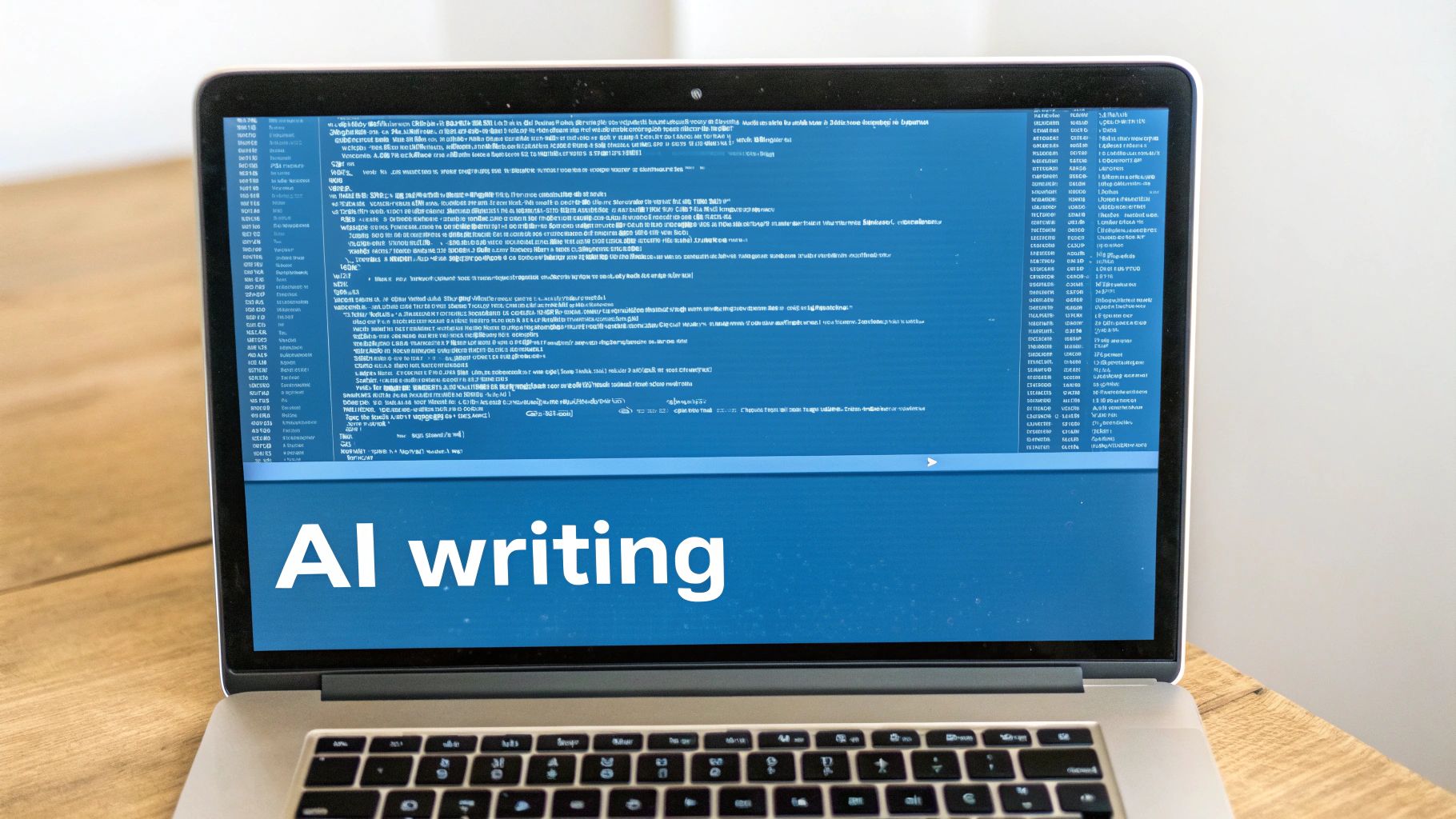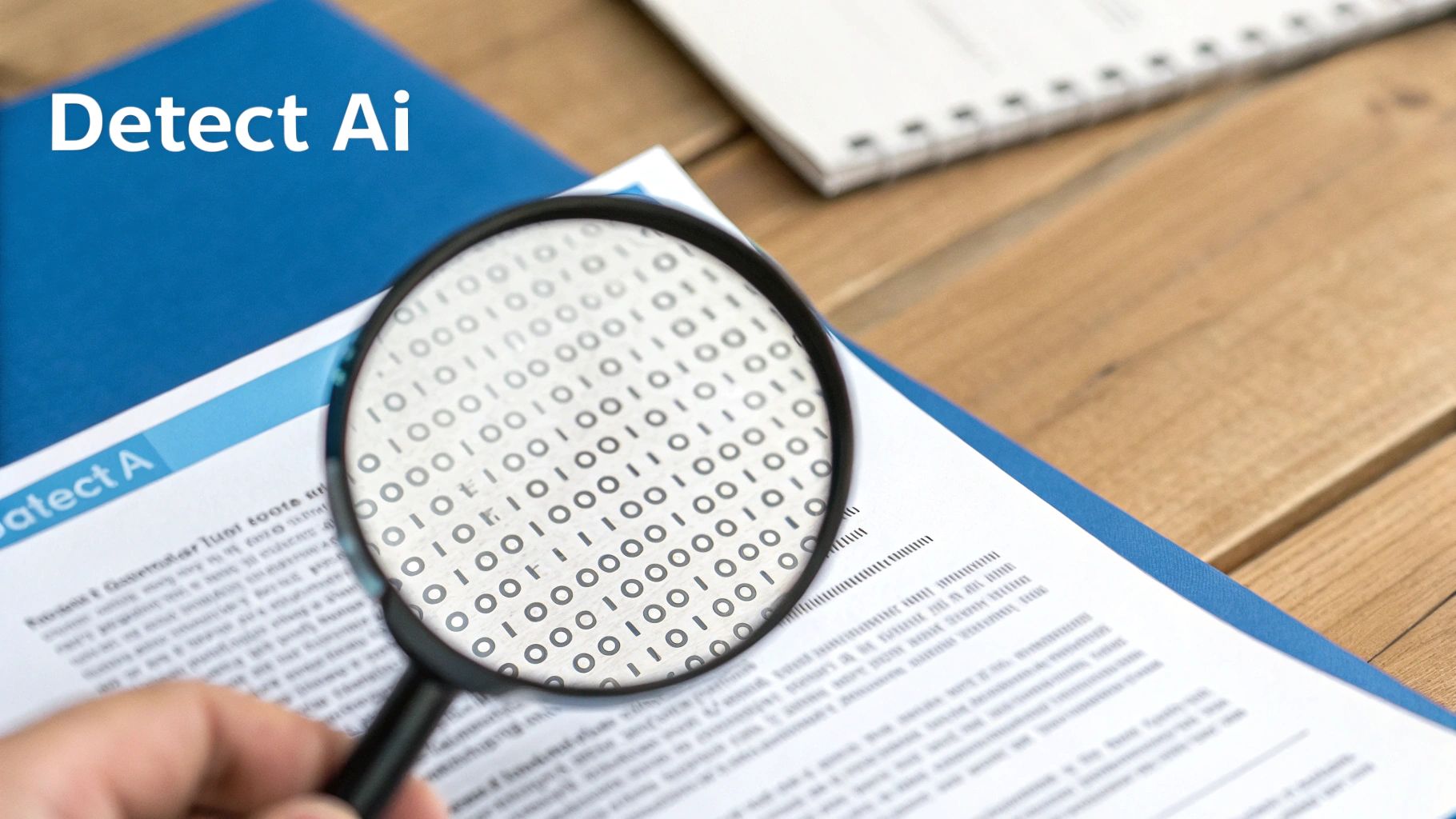Understanding Today's AI Content Detection Landscape

Content professionals face a growing need to differentiate between human-written and AI-generated text. This goes beyond basic plagiarism checking – it's about preserving authentic human creativity and expression. Academic institutions need to verify original student work, while news organizations must prevent the spread of AI-generated misinformation that could mislead readers.
Key Challenges in AI Content Detection
The rapid improvement of AI writing tools presents significant detection challenges. Modern AI can create text that closely resembles human writing patterns, making it harder to identify. Adding to this complexity, human writing sometimes displays patterns that AI detectors flag as machine-generated, resulting in false positives. When humans edit AI-generated content, the distinction becomes even more unclear. As a result, detection tools alone cannot provide complete certainty.
Exploring Current Detection Methods
Detection approaches range from simple to sophisticated analysis techniques. Basic methods scan for repetitive phrases and predictable sentence structures – common signs of early AI writing. But as AI has gotten better at avoiding these patterns, detection now requires deeper analysis of language structure, meaning, and emotional consistency. Some tools specifically examine how emotion and tone flow throughout a piece of writing, since AI often struggles to maintain natural emotional expression.
Accuracy Variations and Reliability Concerns
Recent research in the International Journal for Educational Integrity reveals major differences in how well various detection tools perform. While these tools rarely misidentify human writing as AI-generated, their success at catching actual AI content varies widely – from less than 20% to nearly 100% accuracy. This shows why using multiple tools is important. The training data also affects tool performance significantly – detectors trained on older AI writing may miss content from newer models.
Adapting to the Evolving Landscape
Effective content evaluation requires using multiple detection methods together while applying human judgment. This means understanding current technology's limitations and accepting that perfect accuracy isn't always possible. As AI writing capabilities grow more advanced, detection methods must keep pace through ongoing refinement and adaptation. Success depends on balancing automated tools with human expertise to maintain authenticity in content creation.
Mastering Essential Detection Tools and Techniques
As AI-generated content becomes more prevalent, understanding how to detect it effectively requires moving beyond basic plagiarism tools. Success depends on knowing both how specialized AI detection tools work and how to properly interpret their results. Let's explore the key aspects of identifying AI-written content reliably.
Evaluating Leading AI Detection Solutions
The field of AI content detection has several standout platforms worth examining. Originality.ai stands out with algorithms that can spot AI-written text with up to 99% accuracy – making it particularly valuable for educators and publishers. Another strong option is Copyleaks, which maintains an impressively low 0.2% false positive rate. While these tools perform well, it's important to note that no single detector is perfect given the complex challenge of distinguishing between human and AI writing.
Combining Tools for Enhanced Accuracy
Many successful teams find that using multiple detection tools in tandem yields better results. Just as medical diagnoses often require several tests, content verification benefits from combining different detectors' strengths. For example, one tool may excel at finding repetitive text patterns while another better identifies emotional tone inconsistencies. Cross-referencing results from multiple tools provides a more complete picture of content origins. For more details, check out our guide on How to Master Content Verification.
Understanding Confidence Scores and False Positives
Making sense of AI detection results requires careful analysis of confidence scores and potential false positives. These scores, shown as percentages, indicate how certain a tool is that AI created the content. Higher scores suggest greater likelihood of AI authorship, but they aren't definitive proof. False positives can occur when human writing happens to share characteristics with AI-generated text, like simple sentence structures or repeated phrases.
Practical Strategies for Content Authenticity Verification
Beyond using detection tools, several practical approaches help determine content authenticity:
- Analyzing Writing Style and Tone: Check if the writing flows naturally or seems mechanical and formulaic. Look for consistency in voice and vocabulary throughout the piece.
- Checking for Factual Accuracy: Since AI sometimes creates false information, fact-check specific claims and details to spot potential fabrications.
- Considering the Context: Evaluate where the content appears – is it from a trusted source or a site known for spreading false information?
The most effective approach combines AI detection tools with careful human analysis. This dual strategy helps navigate the growing challenge of verifying content authenticity while protecting genuine human creativity and reliable information sharing.
Breaking Down the Science of Content Analysis

Now that we understand the tools and techniques for detecting AI-generated content, let's explore the scientific principles that make detection possible. By grasping how these tools analyze writing, we can better interpret their results and sharpen our own detection abilities. This involves identifying key linguistic signals in AI writing and seeing how human analysis works alongside automated detection.
Decoding Linguistic Patterns and Statistical Markers
AI writing has distinct patterns that set it apart from human writing. Just like a musician adds personal flair and variation to a piece, human writers naturally vary their word choices and sentence structures. AI, on the other hand, often falls into repetitive patterns and predictable phrasing. The emotional tone in AI writing can feel mechanical or disconnected, with sudden shifts that seem out of place. These subtle but telling signs help distinguish machine-generated text from human writing.
Analyzing Writing Style, Emotional Consistency, and Structural Patterns
Effective content analysis looks at three main areas: style, emotion, and structure. Style analysis goes beyond basic grammar to examine word choice, sentence complexity, and how ideas connect. For example, does the writing feel natural and engaging, or stiff and formulaic? Emotional consistency tracks whether the tone stays appropriate throughout or feels artificial. Structure analysis examines paragraph length, sentence variety, and overall organization. Together, these elements reveal important clues about content origin.
Key Indicators and Common Pitfalls in AI Detection
Several reliable signs can point to AI-written content, including overused phrases, limited vocabulary range, and a lack of personal perspective or real-world examples. However, detection requires avoiding common mistakes. Relying only on automated tools can lead to false positives – much like spell-check sometimes flags correct but unusual words. Another error is examining individual sentences in isolation rather than evaluating how the entire piece flows together. Developing accurate detection skills takes practice and requires looking at content from multiple angles. The most effective approach combines automated tools with careful human review, allowing us to spot AI content while avoiding misidentification of human writing. By understanding these scientific principles and common challenges, we can make more accurate assessments about content authenticity.
Real-World Testing and Performance Insights
Understanding how AI content detectors work in actual practice is essential for anyone looking to evaluate and implement these tools effectively. While theoretical capabilities matter, what's truly important is how well these tools perform when analyzing real content across different types and styles. Let's explore practical testing approaches and examine what leading organizations have learned about measuring accuracy and ensuring quality.
Benchmarking Accuracy Across Diverse Content
AI detection tools don't deliver consistent results across all scenarios. Their accuracy changes based on several key factors: the specific type of content being analyzed, which AI writing model created it, and the writing style used. For instance, a detector that performs well with academic writing may struggle to identify AI-generated marketing copy correctly. Even tools that effectively catch content from older AI models often have trouble with text from newer versions.
This variability means organizations need to test their detection tools across many different content samples. Companies frequently evaluate performance using diverse test sets that include news articles, blog posts, social media content, and academic papers. This broad testing approach helps reveal where tools excel and where they fall short.
Handling Edge Cases and Maintaining Quality Control
Real-world AI detection comes with challenging edge cases that push tools to their limits. Consider content that mixes human and AI writing, or AI-generated text that humans have heavily edited. These scenarios often produce unclear results that automated tools struggle to evaluate definitively.
This is why many organizations pair automated detection with human review. Skilled analysts can spot subtle writing patterns and inconsistencies that automated tools might miss. By combining technology with human expertise, organizations can better handle complex cases while reducing both false positives and false negatives.
Practical Frameworks for Testing and Evaluation
Building reliable detection capabilities requires a systematic testing approach. Start by creating a diverse test dataset that reflects the content types you commonly work with. Include pure human-written samples, AI-generated content, and hybrid pieces that combine both. This variety helps evaluate how well tools can distinguish between different content sources.
When analyzing results, look beyond simple accuracy rates. Pay close attention to both false positives (human content incorrectly flagged as AI) and false negatives (missed AI content). A tool with a high false positive rate tends to mistakenly flag human writing as AI-generated, while frequent false negatives mean AI content is slipping through undetected. This detailed analysis provides much more insight than overall accuracy numbers alone.
Testing across multiple real-world scenarios while tracking specific error types helps build an effective detection system that works reliably in practice. Focus on gathering concrete performance data rather than theoretical capabilities to develop a truly robust content verification process.
Building Your Detection Strategy
Creating an effective process for detecting AI-written content requires thoughtful planning and execution. Like a skilled investigator piecing together evidence, you'll need to combine automated tools with careful human analysis to reach accurate conclusions. A well-designed strategy helps you consistently verify content authenticity even as AI writing capabilities advance.
Combining Verification Methods for Enhanced Accuracy
Just as doctors use multiple tests to make diagnoses, relying on a single AI detection tool can lead to incomplete or misleading results. Each detection tool has its strengths – some excel at spotting repetitive language patterns while others focus on emotional consistency. Using several tools together provides deeper insights and improves accuracy. You might be interested in: How to master content verification. For instance, if two separate tools flag suspicious patterns in the same text, that signals a need for closer manual review using the techniques covered earlier. This multi-layered approach helps avoid both false positives and false negatives.
Establishing Clear Evaluation Criteria
Creating specific standards for assessing content helps keep the verification process consistent and objective. This includes setting minimum confidence score thresholds, like flagging anything above 90% for additional review. A detailed checklist can guide human reviewers by highlighting key factors to examine, such as emotional tone shifts, logical flow between ideas, and presence of unique personal examples. Having clear criteria ensures everyone follows the same thorough evaluation process.
Maintaining Quality and Scaling Efforts
As content verification needs grow, keeping quality high while working efficiently becomes crucial. This often involves building dedicated verification teams and creating standard review procedures. Clear documentation and regular team alignment meetings ensure everyone applies evaluation criteria consistently. These practices are especially important when multiple team members handle verification or when dealing with large content volumes. Staying current on AI writing advances and detection tool updates also helps teams adapt their methods over time. By putting these practical approaches in place, organizations can reliably detect AI-generated content while protecting content authenticity.
Navigating Future Developments in AI Detection

The tools and methods we use to identify AI-written content are advancing quickly alongside AI writing capabilities. Organizations and content reviewers must stay alert to these changes and adapt their approaches accordingly. Success requires understanding how AI writing technology is progressing and what that means for maintaining content authenticity.
Anticipating Advancements in AI Writing Technology
Current AI writing tools still struggle with elements like humor, emotional depth, and natural storytelling. However, future models will likely become much better at these nuanced aspects of writing that currently help distinguish AI from human content. For example, AI may soon craft compelling personal anecdotes or weave subtle metaphors throughout a piece – capabilities that will make detection more challenging. Content reviewers will need new strategies that look beyond surface-level patterns to identify AI writing as it becomes more human-like.
Emerging Detection Methodologies and Technologies
The next generation of AI detection will likely analyze content more deeply by examining the underlying logic, reasoning patterns, and contextual understanding demonstrated in the writing. Much like a detective piecing together evidence, effective detection may require combining multiple tools and approaches to build a complete picture. This could involve integrating linguistic analysis, fact verification, and human review into unified detection platforms that provide more reliable results.
Adapting Verification Processes for Future Challenges
As AI-generated content grows more complex, organizations need multi-layered verification systems that merge automated scanning with expert human assessment. Building strong networks within the content authentication community will be essential for sharing insights and best practices. For example, collaborative projects could focus on developing standardized test datasets that accurately reflect how AI writing capabilities are advancing.
Practical Strategies for Future-Proofing Your Approach
Success requires commitment to ongoing learning and refinement of detection methods. This means regularly evaluating tool performance, exploring emerging technologies, and updating processes based on real-world experience. You might be interested in: How to master content verification with our Chrome extension. Much like cybersecurity teams must constantly update their defenses, content authentication requires staying vigilant about new developments. Building partnerships with technology providers helps ensure access to the latest detection capabilities. By maintaining flexibility and foresight, organizations can effectively identify AI content while preserving their content standards.
Ready to take control of your content and ensure its authenticity? Explore SmartStudi's suite of AI-powered tools designed to help you detect AI writing, paraphrase text, generate essays, create citations, summarize large texts, and even check your grammar. Visit SmartStudi today!
